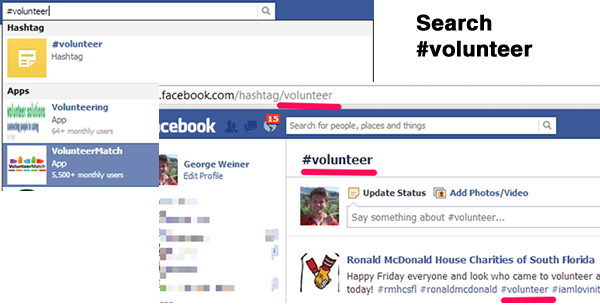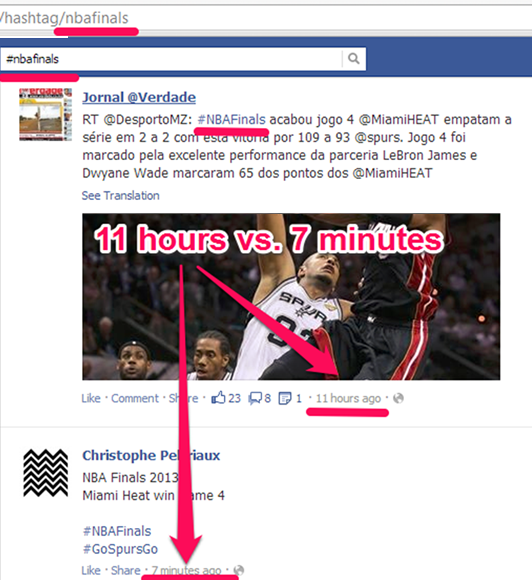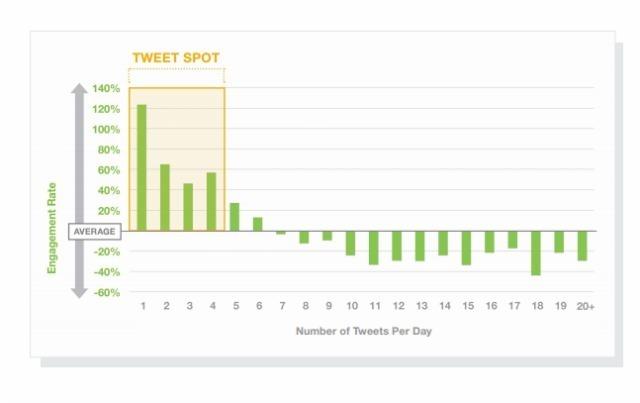We love it when major platforms change up the rules and create opportunities for nonprofits to experiment with increasing their reach. The 2013 addition of hashtags on Facebook was one of those moments, and since then the social network has been fostering more engagement through that ubiquitous sign formerly known as the pound key (#throwbackthursday). Hashtags work by aggregating related content and were especially popular on Twitter (and later Instagram) for aggregating related conversations with limited character space. Here’s how hashtags on Facebook differ, and how they have changed social media marketing strategy, via 5 quick tips.
1. #Search is a #Strategy

Any hashtag can be found by typing # followed by your desired topic. Or you can use the URL facebook.com/hashtag/{topic} to pull up an aggregate of Facebook posts related to the intended tag.
This means that more people will be looking for conversations around topics they care about, and if your organization is making relevant posts, you’re more likely to be liked (or at least be included in that engagement). Note that VolunteerMatch shows up in the initial #volunteer hashtag search, but Ronald McDonald House Charities of South Florida shows up for the most recent post once searched.
2. Post Likes Increase Hashtag Relevancy in User Feeds
When looking for #NBAfinals on my Facebook account, the first post that I’m shown is one by Averdade — a Mozambican paper that I volunteered with a few years ago. Though I don’t speak Portuguese, Facebook’s relevancy algorithm will prioritize posts by pages and people I like over a domain expert such as the NBA’s official Facebook page. Liking a page seems to prioritize their content for as long as 11 hours.
Facebook’s feed continues to be based on pages and posts you “like” that are talking about a topic, prioritized by time. As the social network continues in 2018 to also prioritize real users and real people over #fakenews, posts that generate more comments (either within your own network or the networks of friends) are seeing even greater prioritization in Facebook’s latest API. After all of this, you’ll see posts by things you don’t know or like, with the most recent updates showing up first.
Interestingly, there is no priority given to those geographically closer to you, so your posts can be seen all around the globe!

3. With Hashtags on Facebook, Real-Time Really Matters
It shouldn’t surprise us that Facebook wants more money and more eyeballs. Live events and TV shows now have another backchannel of conversation, which means organizations that care about national politics may want to be as active on Facebook as they are on Twitter during these high relevance times.
Aim for relevant hashtags that are driving conversation to keep the comments coming in to further play nice with Facebook’s most recent algorithm updates. You can always judge the most effective related hashtags by volume and use of high-engagement pages, or through tools like Hashtagify.me or Sprout Social.
4. With Hashtags on Facebook, Aim for More Posts Per Day

Prior to hashtags on Facebook, sources like Mashable and analytics companies like Socialbakers noted that most Facebook Pages posted once per day. For Twitter, @GuyKawasaki recommends Tweeting around 4 times per day, spaced out evenly. BuddyMedia data also supports a 4-Tweet-a-day diet.
The dynamic on Twitter encourages more posts because timing is king when people log in and browse their feed. If a post hasn’t happened within the last hour, the likelihood of it being found drops off a cliff.
Facebook maintains a similar attention economy, which probably explains why, in 2018, the platform sees its users accessing the website an average of 8 times per day, compared to Instagram (6), Twitter (5), and Facebook messenger (3). Overall, time spent on the site is also down (an average of 35 minutes per day), meaning that people are checking at a higher rate of intervals, but not scrolling as far.
Consider testing an extra hashtag-focused post per day and look at your data to decide what is best.
Bonus tip 4.5: #Dont #overdo #it #with #the #hashtags
According to the most recent Sprout Social data, 1 to 2 hashtags on Facebook posts work best, and hashtags with 10+ characters see more engagement.
5. Continue to expect (a lot of) Changes
There is only one immutable truth about Facebook: If a thing makes money, they will do more of it. Back when hashtags debuted on Facebook in 2013, we predicted a number of innovations that came to pass — more ads, prioritization of the Facebook feed would include the amount of engagement, more privacy violations to allow for public Facebook posts (kinda wish we weren’t right about that one), and trends. Some of these changes seem to be swinging back for the sake of real news, but there is bound to be more on the horizon. We’re hashtag-standingby.


